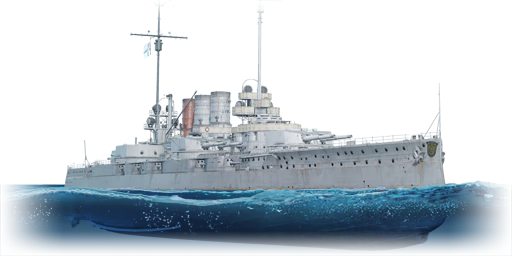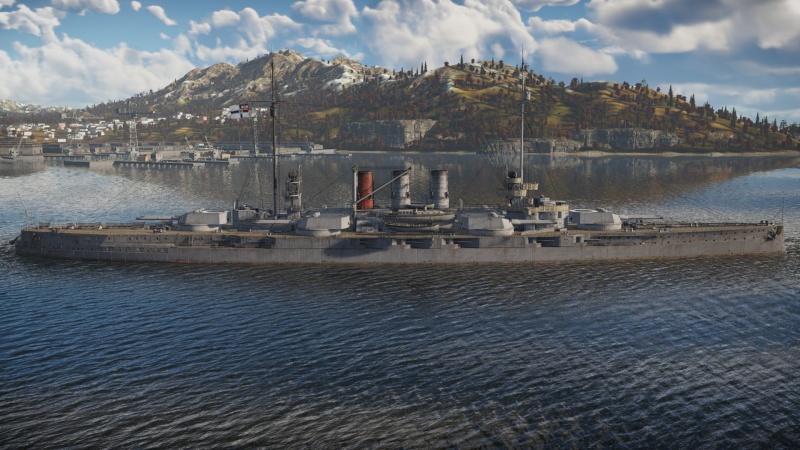SMS Ostfriesland
Contents
Description
The Helgoland-class, SMS Ostfriesland, 1911 is a gift rank V German battleship with a battle rating of 6.3 (AB/RB/SB). It was introduced during Update "Drone Age" as a reward for the 2022 Project "Overpowered" event.
General info
Survivability and armour
Talk about the vehicle's armour. Note the most well-defended and most vulnerable zones, e.g. the ammo magazine. Evaluate the composition of components and assemblies responsible for movement and manoeuvrability. Evaluate the survivability of the primary and secondary armaments separately. Don't forget to mention the size of the crew, which plays an important role in fleet mechanics. Save tips on preserving survivability for the "Usage in battles" section. If necessary, use a graphical template to show the most well-protected or most vulnerable points in the armour.
Mobility
Write about the ship's mobility. Evaluate its power and manoeuvrability, rudder rerouting speed, stopping speed at full tilt, with its maximum forward and reverse speed.
| Mobility Characteristics | |||
|---|---|---|---|
| Game Mode | Upgrade Status | Maximum Speed (km/h) | |
| Forward | Reverse | ||
| AB | |||
| Upgraded | 46 | 25 | |
| RB/SB | |||
| Upgraded | 39 | 22 | |
Modifications and economy
Armament
Primary armament
Provide information about the characteristics of the primary armament. Evaluate their efficacy in battle based on their reload speed, ballistics and the capacity of their shells. Add a link to the main article about the weapon: {{main|Weapon name (calibre)}}. Broadly describe the ammunition available for the primary armament, and provide recommendations on how to use it and which ammunition to choose.
| Penetration statistics | |||||||
|---|---|---|---|---|---|---|---|
| Ammunition | Type of warhead |
Penetration @ 0° Angle of Attack (mm) | |||||
| 1,000 m | 2,500 m | 5,000 m | 7,500 m | 10,000 m | 15,000 m | ||
| Spgr. L/3.8 Bdz | HE | 167 | 149 | 124 | 103 | 87 | 66 |
| Spgr. L/3.3 SAP | SAP | 481 | 430 | 357 | 299 | 252 | 193 |
| Psgr. L/3.4 | APC | 519 | 463 | 383 | 320 | 270 | 205 |
| Shell details | ||||||||||||
|---|---|---|---|---|---|---|---|---|---|---|---|---|
| Ammunition | Type of warhead |
Velocity (m/s) |
Projectile mass (kg) |
Fuse delay (s) |
Fuse sensitivity (mm) |
Explosive mass (TNT equivalent) (kg) |
Ricochet | |||||
| 0% | 50% | 100% | ||||||||||
| Spgr. L/3.8 Bdz | HE | 855 | 405.9 | 0.025 | 17 | 27 | 79° | 80° | 81° | |||
| Spgr. L/3.3 SAP | SAP | 850 | 410 | 0.025 | 17 | 10.8 | 47° | 60° | 65° | |||
| Psgr. L/3.4 | APC | 855 | 405.5 | 0.025 | 17 | 13.6 | 48° | 63° | 71° | |||
Secondary armament
Some ships are fitted with weapons of various calibres. Secondary armaments are defined as weapons chosen with the control Select secondary weapon. Evaluate the secondary armaments and give advice on how to use them. Describe the ammunition available for the secondary armament. Provide recommendations on how to use them and which ammunition to choose. Remember that any anti-air armament, even heavy calibre weapons, belong in the next section. If there is no secondary armament, remove this section.
| Penetration statistics | |||||||
|---|---|---|---|---|---|---|---|
| Ammunition | Type of warhead |
Penetration @ 0° Angle of Attack (mm) | |||||
| 1,000 m | 2,500 m | 5,000 m | 7,500 m | 10,000 m | 15,000 m | ||
| Sprgr. L/4.1 Kz | HE | 21 | 21 | 21 | 21 | 21 | 21 |
| Sprgr. L/4.1 Bdz | SAPBC | 95 | 80 | 61 | 47 | 37 | 28 |
| Psgr. L/3.7 | APCBC | 238 | 201 | 153 | 117 | 93 | 71 |
| Shell details | ||||||||||||
|---|---|---|---|---|---|---|---|---|---|---|---|---|
| Ammunition | Type of warhead |
Velocity (m/s) |
Projectile mass (kg) |
Fuse delay (s) |
Fuse sensitivity (mm) |
Explosive mass (TNT equivalent) (g) |
Ricochet | |||||
| 0% | 50% | 100% | ||||||||||
| Sprgr. L/4.1 Kz | HE | 835 | 45.3 | 0 | 0.1 | 1,600 | 79° | 80° | 81° | |||
| Sprgr. L/4.1 Bdz | SAPBC | 835 | 45.3 | 0.01 | 7 | 1,050 | 48° | 63° | 71° | |||
| Psgr. L/3.7 | APCBC | 835 | 45.3 | 0.015 | 7 | 990 | 48° | 63° | 71° | |||
Anti-aircraft armament
An important part of the ship's armament responsible for air defence. Anti-aircraft armament is defined by the weapon chosen with the control Select anti-aircraft weapons. Talk about the ship's anti-air cannons and machine guns, the number of guns and their positions, their effective range, and about their overall effectiveness – including against surface targets. If there are no anti-aircraft armaments, remove this section.
Additional armament
Describe the available additional armaments of the ship: depth charges, mines, torpedoes. Talk about their positions, available ammunition and launch features such as dead zones of torpedoes. If there is no additional armament, remove this section.
Usage in battles
Describe the technique of using this ship, the characteristics of her use in a team and tips on strategy. Abstain from writing an entire guide – don't try to provide a single point of view, but give the reader food for thought. Talk about the most dangerous opponents for this vehicle and provide recommendations on fighting them. If necessary, note the specifics of playing with this vehicle in various modes (AB, RB, SB).
Pros and cons
Pros:
- Very good protection
- Great firepower
Cons:
- Bad anti-air capabilities
- Lacklustre torpedoes
- Poor manoeuvrability
History
The SMS Ostfriesland stood as the second ship among the Helgoland class of formidable dreadnought battleships within the Imperial German Navy. Honoring the East Frisia locale, construction of Ostfriesland commenced in October 1908 at the Kaiserliche Werft shipyard in Wilhelmshaven. The vessel was officially christened on 30 September 1909 and entered active service on 1 August 1911.
Together with her three sibling vessels, Helgoland, Thüringen, and Oldenburg, Ostfriesland took part in all significant fleet maneuvers of World War I in the North Sea, engaging the British Grand Fleet. Notably, she played a pivotal role in the Battle of Jutland from 31 May to 1 June 1916, marked as the most extensive naval confrontation of the conflict. Additionally, the ship actively participated in Baltic Sea operations against the Russian Navy, notably contributing to the initial unsuccessful incursion into the Gulf of Riga in August 1915.
Media
Excellent additions to the article would be video guides, screenshots from the game, and photos.
See also
Related development
External links
| Kaiserliche Werft Wilhelmshaven | |
|---|---|
| Battleships | |
| Nassau-class | SMS Nassau |
| Helgoland-class | SMS Ostfriesland |
| See also | (Reichsmarine-) Kriegsmarinewerft (1918 - 1945) |
| Germany battleships | |
|---|---|
| Nassau-class | SMS Nassau · SMS Westfalen |
| Helgoland-class | SMS Helgoland · SMS Ostfriesland |
| Kaiser-class | SMS Kaiser |
| Bayern-class | SMS Bayern · SMS Baden · SMS Sachsen |





